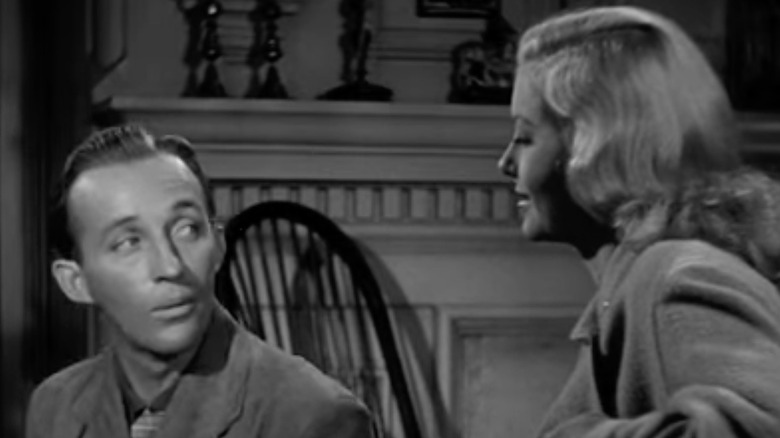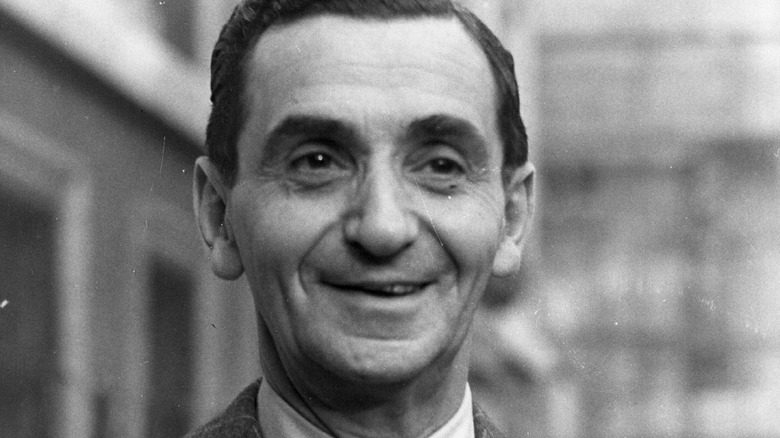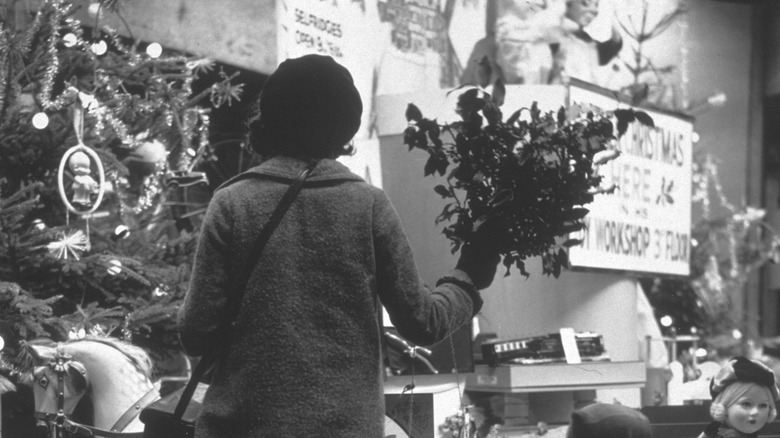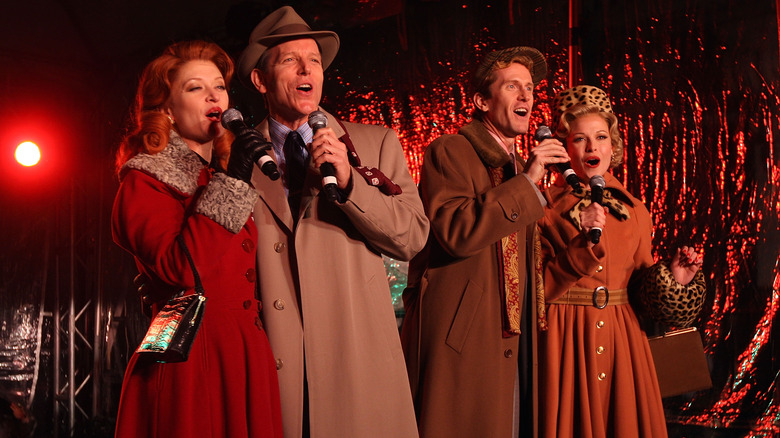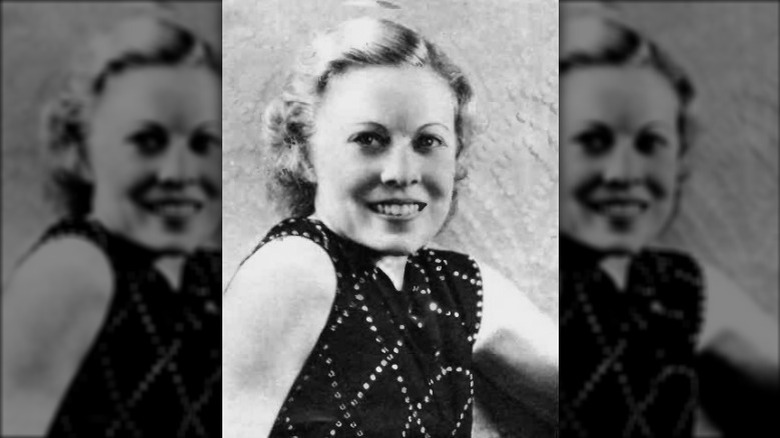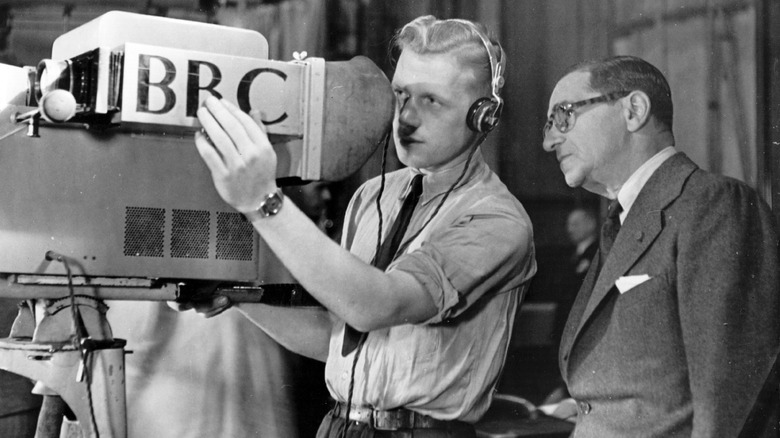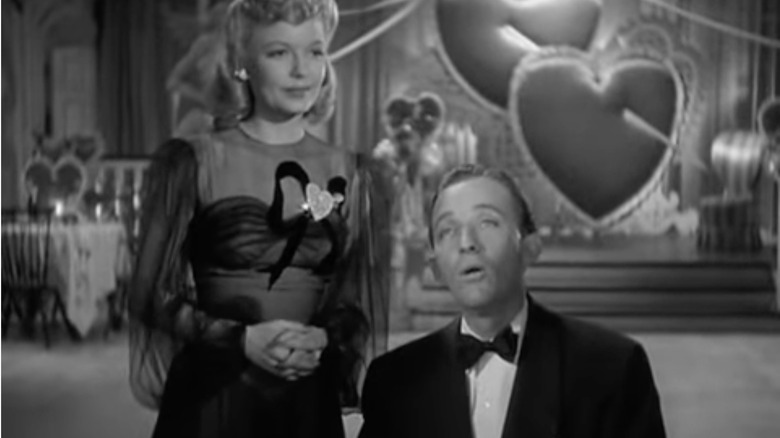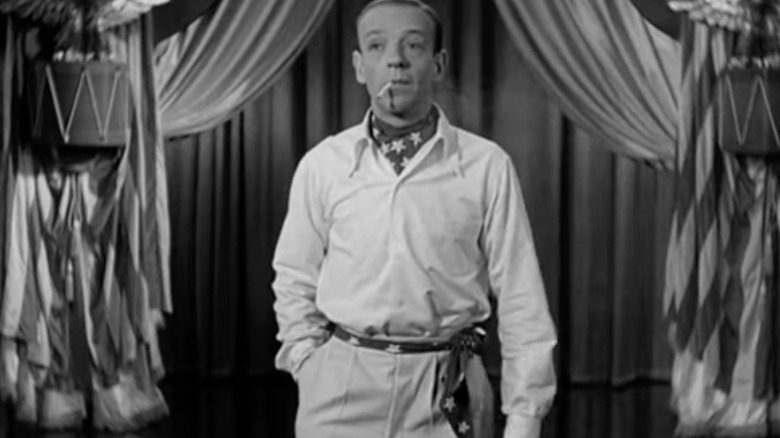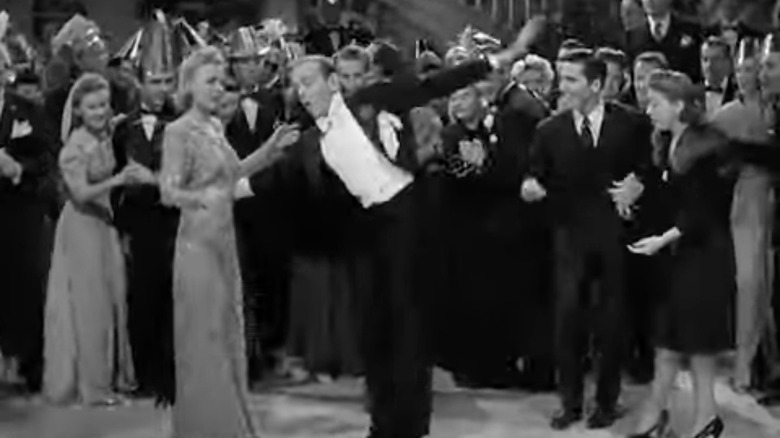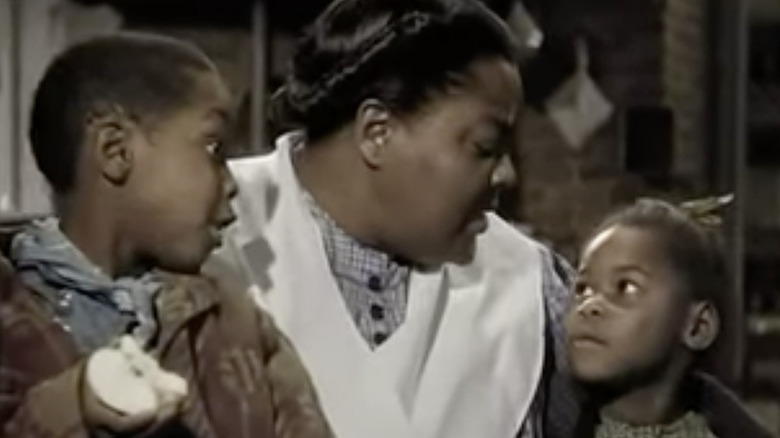The Untold Truth Of Holiday Inn
In Charles Dickens' "A Christmas Carol," antagonist-turned-protagonist Ebenezer Scrooge experiences revelations about the world and his place in it by exploring Christmas past, present, and future. Various ghosts help Scrooge travel to different chronological points in his life, relying on the Yuletide theme to tie the discoveries he makes together.
Although we can't call on the services of a Christmas ghost to explore America's Yuletide past, Hollywood has left countless "time capsules" in the form of films. These old-school reels offer a glimpse into just how much the nation has evolved over the decades. An example of this is 1942's "Holiday Inn," a movie that lets us explore America's midcentury experience through the lens of the war years, catching glimmers of both holiday glee and scathing controversy. In other words, the film represents a mixed bag when it comes to Christmas classics.
On the one hand, it boasts the original version of Irving Berlin's classic hit "White Christmas," one of our nation's most beloved holiday melodies. On the other hand, it contains the controversial number "Abraham," which underscores just how recent the scars of racism remain in the United States. But these facts are just the tip of the iceberg when it comes to "Holiday Inn's" history and impact on American society, past and present.
Irving Berlin spent years honing the idea
Irving Berlin had long wanted to write a musical based on the idea of an inn only open for the holidays, according to Laurence Bergreen's biography "As Thousands Cheer: The Life of Irving Berlin." Some say he came up with the concept of a Broadway revue focusing on major American holidays as early as 1933 while writing the song "Easter Parade" for the Broadway play "As Thousands Cheer."
But Berlin never realized his dream in its original Broadway form, and he wouldn't sign on for "Holiday Inn" until May 1940. Filming at Paramount Pictures began in November 1941 and finished in January 1942, paving the way for a massive release in August 1942. But Berlin despised what he saw as the glacial pace of the production.
Bergreen quotes Berlin, "I wrote "Holiday Inn" in 1941, and it wasn't until 1942 or later that people saw it ... All that time the songs are hidden away, and you have no way of knowing whether the songs will be accepted or rejected. There is even the possibility that someone may duplicate one of your best ideas in the meantime." It didn't help that Berlin labored excessively over the movie, refusing to take meal breaks and working day and night.
Fighting a war enhanced the movie's message
Celebrating the holidays and affirming the American way of life became more critical as the world's second global conflict exploded. And Irving Berlin recognized this. According to Laurence Bergreen's "As Thousands Cheer: The Life of Irving Berlin," the movie "Holiday Inn" filled an important void during the war years with its emphases on what mattered most to the average American: family, home life, and the simple pleasures.
Countless families remained separated during the holidays (and for years at a time). So, the collective experience of watching the same movies, even while oceans apart, must've provided some solace. And for the soldiers who dealt with the horrors of combat every day, reminders of home life buttressed morale and kept them focused on what they fought for. In other words, Berlin used "Holiday Inn" as a way of "endorsing the American way of life" without getting caught up in politics and the nastier aspects of the war in Europe and the Pacific.
Entertainment trumped propaganda, which provided the film with a timelessness many people still enjoy today. Among the songs that have best stood the test of time is "White Christmas," which operates outside a specific place, time, or popular trend. Of course, timelessness doesn't apply to the anachronistic ugliness of "Abraham." (More on this later.) But for homesick soldiers and families missing loved ones, "Holiday Inn" provided 100 minutes of escape (via Jeremy Arnold's "Christmas in the Movies.")
Holiday Inn was tailormade to showcase Irving Berlin's songs
Besides providing people with a sense of nostalgia as war dominated every aspect of life, the movie also marked the ideal vessel for showcasing Irving Berlin's songwriting talents, according to Jeremy Arnold's "Christmas in the Movies." The film covers more than two years and eight American holidays, including several treatments of Christmas. The holiday numbers get meted out by a veteran song-and-dance team, Fred Astaire and Bing Crosby.
According to the storyline, Crosby has retired from the team to Connecticut, where he runs an inn specializing in holiday spectacles. And Astaire soon follows. The men become embroiled in two love triangles, making for a lighthearted rom-com set to the backdrop of America's favorite holidays. These occasions also provide the perfect opportunities to introduce musical numbers penned by Berlin.
Berlin struggled the most creating a fitting Christmas song, at least in part because of his Jewish roots. Laurence Bergreen suggests in his book "As Thousands Cheer: The Life of Irving Berlin" that writing "White Christmas" marked the limit of the great composer's "musical assimilation." But Bergreen also notes that the problem of writing the perfect Christmas song ran much deeper than personal religious convictions. Berlin needed to develop something "simple, universal, and unforgettable." As the show's climactic performance, it had to exist on a par with classics like "God Bless America." Bringing this together marked no small achievement. But Berlin pulled it off with aplomb.
Aspects of the movie are all Hollywood varnish and fantasy
Although Marjorie Reynolds appeared as the lead in "Holiday Inn," her singing voice doesn't grace the movie's hits. According to "Movies Magnificent: 150 Must-See Cinema Classics" by John Reid, you're listening to Martha Mears (pictured). She dubbed the voice of Linda Mason in numbers like "White Christmas" and "Come to Holiday Inn."
In an article that appeared in the Moberly Monitor-Index in 1952, Mears would describe dubbing as "ghost singing," explaining that it required adapting her voice to each actress she worked with to ensure a successful and convincing portrayal. Although the article doesn't mention Mears' work on "Holiday Inn" specifically, a simple Spotify search reveals her credit as the singer of "White Christmas" along with Bing Crosby. Besides dubbing Marjorie Reynolds, Mears worked with many other Hollywood celebrities, including Rita Hayworth, Hedy Lamarr, Veronica Lake, and Eva Gabor, gifting them with her velvety vocals.
But the fake aspects of the movie don't end there. In the scenes depicting a winter wonderland, the snow used to fall on the set of "Holiday Inn" was crafted from white asbestos chrysotile. According to the National Asbestos Helpline, asbestos-laced Christmas decorations dominated the 1940s. Fake asbestos snow went by brand names like Snow Drift, Pure White, and White Magic, and you can only imagine the havoc it wreaked on the lungs of those who breathed it in during filming.
Irving Berlin proved a control freak on set
When "Holiday Inn" started filming, Irving Berlin had made a big enough name for himself to enjoy huge creative liberties. In "As Thousands Cheer: The Life of Irving Berlin," author Laurence Bergreen notes that the musical maverick hand-assembled the team he wanted to work with for "Holiday Inn." Berlin hired Mark Sandrich to direct the film, believing Sandrich was the best man on the planet to stage his songs.
But Berlin wanted complete control in other areas, like songwriting, discussing choreography, and attending story conferences. He demanded the right to approve every single note performed for the movie. This made him a control freak in some people's eyes and ensured he had to stay on the West Coast throughout filming. After all, "Holiday Inn" contained 12 nearly back-to-back songs by Berlin (via Jeremy Arnold's "Christmas in the Movies"). For a composer who originally envisioned creating a Broadway musical revue, the stint in Hollywood must've proved challenging.
Berlin hired Walter Scharf as orchestrator, bringing confident fluidity to the movie. Scharf would later describe Berlin's work ethic as impressive yet obsessive. When it came to "White Christmas," he recollected, "It was as if [Berlin] were going to have a baby when he was working on that song." Scharf would also later recall that Berlin hid out during the filming of Bing Crosby's rendition of "White Christmas," finding himself incapable of relinquishing control of "his precious song."
The film's music garnered an Academy Award
The hard work Irving Berlin put into "Holiday Inn" would pay off during Hollywood's most fabled annual event, the Academy Awards. The 15th Academy Awards took place at the Ambassador Hotel's Cocoanut Grove on Thursday, March 4, 1943, per the Oscars. "Holiday Inn" received a handful of Academy Award nominations. They included nominations for Best Writing (Original Story) and Best Music (Scoring of a Musical Picture).
But Irving Berlin clinched the Academy Award for his song "White Christmas." In an awkward and memorable moment, he ended up giving the award to himself as the Academy picked him to present that category, per the Oscars. Perhaps this proved fitting considering his reputation for controlling every aspect of the staging and production of the film. Winning the award for "White Christmas" likely also surprised Berlin. After all, he had placed his money on another song written for the film.
Instead of "White Christmas," Irving Berlin initially thought "Be Careful, It's My Heart" would bring him the most acclaim (via KTEN). This song debuted during the Valentine's Day portion of the movie but lacked the staying power of "White Christmas," which quickly became embedded in American pop culture, where it remains to this day.
White Christmas became an American standard
The American people fell head over heels in love with "White Christmas." It outshone the other songs featured in "Holiday Inn" by a mile. It proved especially touching to war-weary soldiers stationed in Europe and the Pacific during World War II. According to Laurence Bergreen's book "As Thousands Cheer: The Life of Irving Berlin," the composer felt immense joy after completing the piece, realizing he had a hit.
He would later second guess himself, settling on "Be Careful, It's My Heart" as the more likely winner (via Jeremy Arnold's "Christmas in the Movies"). But later doubts don't detract from the initial excitement he felt. The morning after penning the song, Berlin called in his transcriber Helmy Kresa, telling her, "I want you to take down a song I wrote over the weekend. Not only is it the best song I ever wrote, it's the best song anybody ever wrote." Although Kresa assumed her boss was being egotistical, his words proved remarkably prescient.
According to Hymns and Carols of Christmas, Bing Crosby's song recording sold like hotcakes, drumming up 30 million in album sales globally. Billboard reports that the version recorded by Bing Crosby would remain the largest selling "single" in history until Elton John's "Candle in the Wind 1997" unseated it following the tragic death of Princess Diana. In 2004, "White Christmas" was listed as No. 5 on the American Film Institute's "100 Songs ... 100 Years."
Say It with Fireworks amped up the patriotism
In "Say It With Fireworks," Fred Astaire pulls off a complicated dance. According to Jeremy Arnold in "Christmas in the Movies," the choreography involves firecrackers, creating a one-of-a-kind Independence Day-themed performance. Firecrackers lined the floor, designed to go off around Astaire as he danced. But proper execution required a high level of precision and impeccable timing. (And all while he smoked a cigarette!) To get it right, the celebrated dancer rehearsed for three days straight, and it required 38 takes to achieve the cinematic perfection that Irving Berlin, Fred Astaire, and Mark Sandrich could all agree upon.
During filming, on December 7, 1941, the Japanese attacked an American naval base at Pearl Harbor located in Honolulu, Hawaii, per History. This resulted in President Franklin Delano Roosevelt's famed "Declaration of War" on December 8, 1941, in an address before Congress (via the FDR Library). After FDR's monumental speech, the Senate and House of Representatives unanimously approved this declaration launching America into the War in the Pacific.
As every facet of American society turned its gaze towards the war effort, Hollywood amped up its morale-boosting efforts. "Holiday Inn" proved no exception to this rule. That said, the shadow of war also took attention away from Berlin's baby. According to Laurence Bergreen in "As Thousands Cheer: The Life of Irving Berlin," journalists wanted to focus on the war effort instead of Hollywood, and Berlin felt the sting of their fickleness.
The Drunk Dance kept Fred Astaire off-balance
Another iconic dance performed by Fred Astaire during the making of "Holiday Inn" remains the so-called "Drunk Dance" (via YouTube). During this performance, Astaire dances with co-star Marjorie Reynolds in a dizzying display that leaves the audience feeling a little off-balance. As the number progresses, Astaire leans more and more heavily on Reynolds as she appears to help him stay upright and balanced.
One of the most entertaining scenes from the movie, it navigates a delicate balance between elegance and chaos as Astaire appears to sink more and more deeply into the mire of drunkenness. By the end, he collapses in a sloppy pile at her feet. Sorting out the reality from the fantasy in this performance proves tricky. And there's a reason for this.
According to Jeremy Arnold's "Christmas in the Movies," Astaire opted for what you might call "method acting" to bring the full effect of inebriation to life. Before the first take, he downed two bourbon shots and followed up with an additional shot after each subsequent take. Seven takes later, Mark Sandrich settled on the last and most drunken version of Astaire's performance for posterity.
The Abraham Lincoln number underscores a jarring disconnect
The original version of "Holiday Inn" includes a nod to the minstrel shows of the 19th century, known for their use of highly racist language and blackface, per Critical Commons. This scene is known as "Abraham" and commemorates the birthday of President Abraham Lincoln, who signed the Emancipation Proclamation that freed enslaved peoples on January 1, 1863 (via Archives).
"Abraham" has since been cut from most viewings of the film for its racial insensitivity and offensive material. According to the Michigan Quarterly Review, however, Turner Classic Movies (TMC) has caused controversy by keeping the film intact during its screenings due to the network's uncut, unedited policy for all of the movies it shows. The "Abraham" episode is like nails on the chalkboard by today's standards. Getting the image of blackface Bing Crosby and Marjorie Reynolds (complete with a pejorative wig and outfit) out of your mind is a challenge. A full band of blackface musicians accompanies the performers to cringe-worthy effect.
Then, the movie cuts away to Black actress Louise Beavers as Mamie, the house servant, singing to her children about emancipation, creating a startling dichotomy between the "help" and the rich white people dancing in the other room. Jeremy Arnold points out in "Christmas in the Movies" that the 1954 version of "Abraham" featured in "White Christmas" doesn't include blackface. Considered a semi-remake of "Holiday Inn" (via American Profile), the change in presentation indicates shifting societal sentiments across the decades.
Adaptations have extended the shelf-life of Holiday Inn
Before "White Christmas" debuted in 1954, radio kept the "Holiday Inn" flame burning bright. On January 11, 1943, CBS broadcast a half-hour long radio dramatization of "Holiday Inn," featuring Bing Crosby and Dinah Shore (via the Paley Center). Over the next decade, radio dramatizations of "Holiday Inn" would take over the airwaves, including a broadcast on November 19, 1948, starring George Murphy, Martha Tilton, and Gordon McRae, as reported by Podtail.
Of course, one of the most famous homages to "Holiday Inn" would be 1954's "White Christmas," starring Bing Crosby, Danny Kaye, Rosemary Clooney, and Vera-Ellen, per American Profile. Fred Astaire turned down the second lead in the film, and it eventually made its way to Danny Kaye. But Bing Crosby repurposed his hit song as well as the set from "Holiday Inn" for this "semi-remake."
In 2013, Goodspeed Musicals began work on a live theater adaptation of "Holiday Inn" and "White Christmas" based on the book by Gordon Greenberg and Chad Hodge. The production featured Irving Berlin's music from the original movies. This adaptation premiered in East Haddam, Connecticut, on September 19, 2014. Another adaptation of the movie by Roundabout Theatre Company played Broadway at Studio 54 in autumn of 2016, starring Bryce Pinkham, Megan Lawrence, and Corbin Bleu (via Playbill). It finally brought Berlin's dream to life of a Broadway musical revue commemorating America's significant holidays.
